
Despite the Gothic series’ often lukewarm reception in the Western game media, Gothic 2 is increasingly and rightfully coming to be considered a highpoint in RPG exploration and among the best RPGs of the 2000s. The same accolades are never extended to Gothic 3.
Under the one-two punch of being a buggy mess at launch and not being as good as its immediate predecessor, Gothic 3 is largely considered a forgettable entry in the series. Stronger opinions than that exist on either ends of the spectrum, with some defending the merits of the game and the improvements that years of patching have brought, while others revile it and its attempts to abandon the small and packed world of Gothic 2 in favour of a large open world. Some even call it the first step in Piranha Bytes downwards spiral that would culminate in whatever Risen 2 and 3 were trying to do. The fact that its stand-alone expansion, “Forsaken Gods”, which was developed by a different studio, was an unredeemable garbage fire that no sane person would defend did not do the base game any favour in regards to its reputation.
This article falls squarely in that first category of strong opinions. A decade and a half after its release, Gothic 3 has been polished by both official patches and an incredibly complex Community Patch, to the point where it can be judged on its own merits. And I say this as someone who was there. I played Gothic 3 vanilla. I waited through the 5+ minutes long loading screens. I was killed by stunlocking boars dozens of times. I had to change directions in the middle of the fight because the sun’s out of control lens-flare made the game unplayable. And I played it again over the last month for this article. It is a game that is far from perfect, and no amount of patching will solve some dubious design choices. But underneath it all, there is a game that definitely deserves to be played, warts and all.
Losing My Favourite Game
Much like the first two games in the series, Gothic 3 is a third-person role-playing game set in a medieval fantasy world. It’s officially described as an “action RPG”, I guess because combat is determined not only by stats, but also by being good at clicking the mouse at the right time. Whatever.
Your character, the Nameless Hero, finally got rid of his rebellious ponytail and is ready for new adventures upon reaching the mainland of Myrtana. The game begins in medias res, with you and your friends in the middle of a fight against the orcs occupying a small village. The fight is fairly easy and it might give you the wrong idea about the rest of the game. Yes, some enemies are now easier than in previous games, partially because your character doesn’t start as the complete blank slate armed with a stick of previous games, partially because of rebalances. But don’t expect to have a dozen allies by your side in every fight. And what some nerfed creatures, like skeletons, shadowbeasts and event trolls might lose in strength, they definitely gain in numbers.
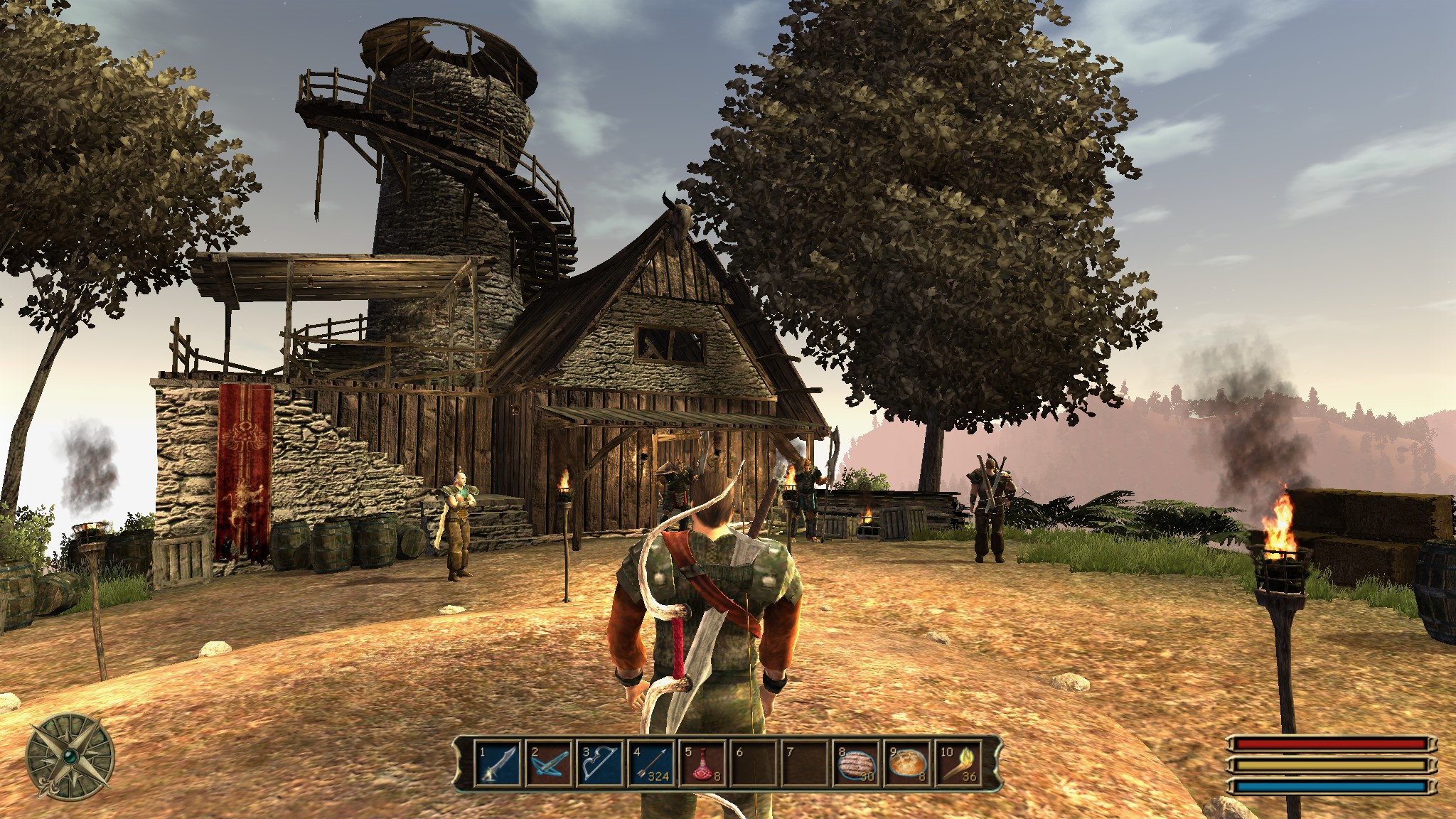
If you come prepared, know what you’re doing and aren’t getting overconfident, you can take your chances with almost any of the game’s monsters even early on. On the other hand, even in the late game, when your stats are nearing godhood and you’re equipped with all-powerful artefacts, most enemies can kill you in seconds if they manage to surround you or attack you from the rear. This creates tension. And this tension dictates a certain way of going about the game. You’ll most likely explore every region with a steady step, bow at the ready, and constantly scanning the horizon for threats and riches, rather than just running carelessly towards the next destination.
The class system is no longer tied to the faction system and players can develop their character as they wish. The Community Patch adds an “alternative balancing” option, making the game harder, but I cannot recommend it. It increases the amount of learning points needed to increase your skills. The skill tree is much too fun to play with to cripple it like that. If you want an extra challenge you’re better off enabling the alternative AI, which makes creatures smarter and more dangerous, rather than artificially locking your options to become a master lock picker, blacksmith or alchemist, just because you needed more learning points to get your strength or ancient knowledge to a decent level. As always, finding the people who can teach you different specialized skills is part of the fun.
The Gothic series has always been adept at putting on a big show with limited resources. The world is filled with “roaming” packs of animals who don’t actually do much more than move from point A to point B, hang around there for a spell, and then go back to point A. Knowing that doesn’t make a dozen ice wolves suddenly emerging into your field of view any less terrifying. The fact that some animals run away when attacked makes a lot of sense, but also paves the way towards two of the most frustrating quests of the game, both of which involve hunting some particular deer. There’s nothing like spending hours searching for the deer that got away only to find it grazing serenely on the other side of the orc’s siege lines.
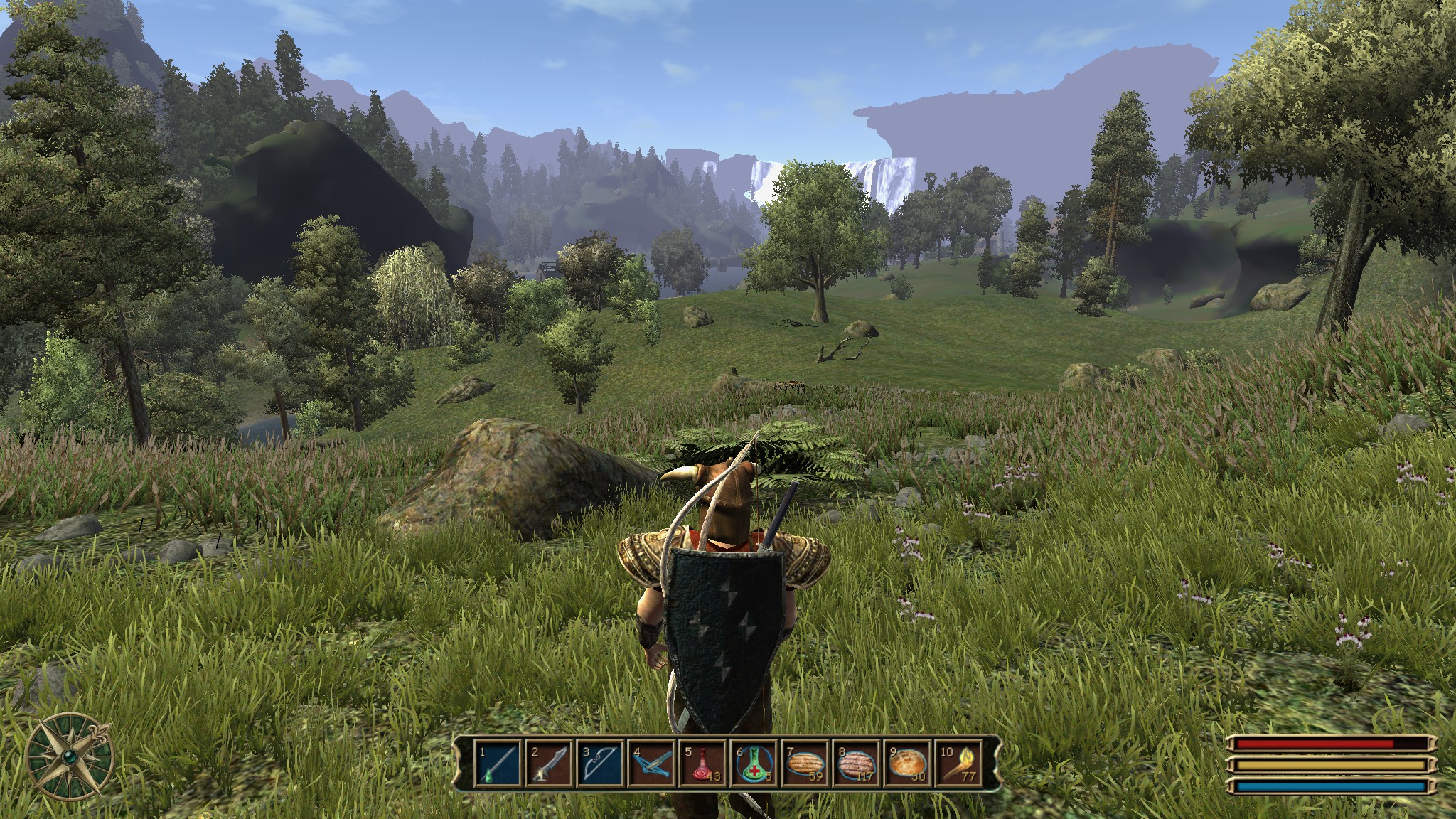
What’s the Story, Morning Glory?
Obsidian’s 2016 RPG Tyranny made a big deal out of taking place in a world where the evil forces already won, but in Gothic 3, Myrtana isn’t that much different. The same orcs that have been waging a brutal war against humanity in the first two games, have allied with Xardas, destroyed rune magic and overrun Myrtana. A small number of humans are still fighting against the occupation and the choice is your if you want to help them in reclaiming the cities from the furry clutches of the orcs, or if you would rather side with the orcs and spend the whole game doing the ignoble work of clearing up rebel hideouts and returning runaway slaves.
The game never tries to make your choice between the rebels and the orcs seem like a morally difficult one. The orcs are unambiguously the bad guys. They’ve enslaved every human in Myrtana except for select mercenaries who proved their loyalty during the war. They don’t seem willing to govern the newly conquered lands as much as they are willing to plunder it in search of ancient artifacts in the name of the dark god Beliar.
The orcs waged and won an ostensibly religious war, but other than building some new shrines and having slaves dig up artifacts, they don’t do much in their newfound position of conquerors other than await for further orders. It’s almost comical, like a dog that finally manages to catch its own tail and has absolutely no idea what to do with it. It might not make for a riveting narrative, but this status quo is, however, perfect for a game that allows you to go pretty much anywhere from the start, if you have the guts for it, and complete quests in any order, without fear that the other side of the world isn’t going to wait for you.
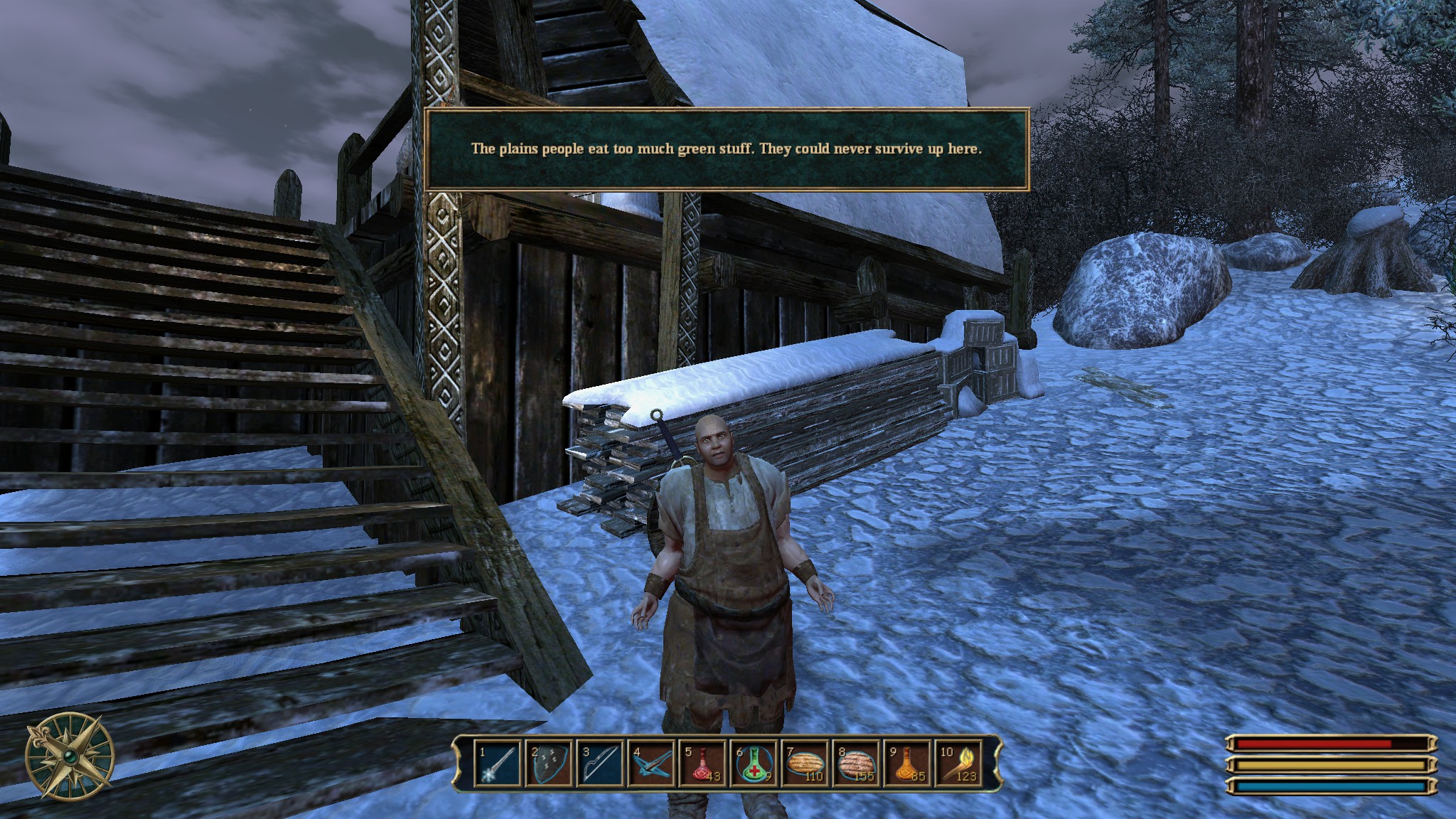
The first two games in the series used the fact that they were set in fairly isolated parts of the world to avoid telling you too much about Myrtanan society. You knew there was a king and there was a war with the orcs and that was about it. Now, that you are at the center of the Myrtanan civilization, you will not learn much more. Other than some vague mutterings about the conflict between the Gods, you won’t get to explore the lore of the land, simply because there doesn’t seem to be one.
Most of your conversations will be about practical things, not the nature of the world or the intricacies of society. Gothic 3 uses the same flavour of short, snappy and somewhat incredulous dialogues as previous games in the series. The hammy acting is still there and it is still glorious.
The world of Gothic only makes sense if you don’t think about it too much. I get why there are no children in the game, a lot of games do that, but where the hell are all the women? I mean, they exist, both the Rebels and the Nordmarian clans have female members, but there’s probably something like 25 men to every woman in the game. And I’m struggling to think of more than one named, speaking female character in the entire game. A game that contains hundreds of named, speaking characters. This is not new to the series: The first Gothic’s only female characters were the notorious sex slaves, but at least they had a better explanation, being a prison, for why there were barely any women. Gothic 3 doesn’t even try to explain this in any way. For the purposes of gender equality, my head-canon is that every single orc in the game is female
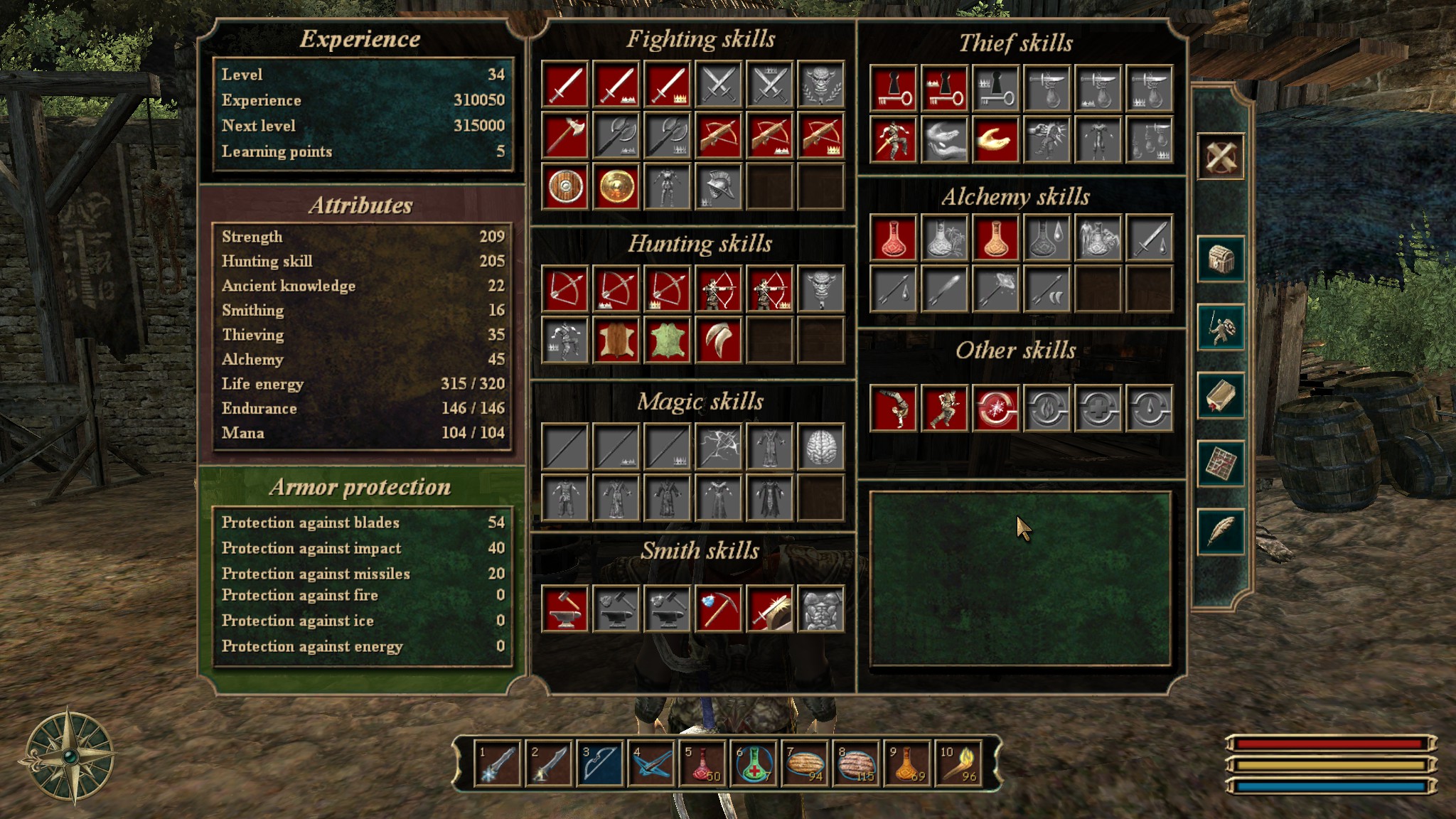
The World is Not Enough (But It is Such a Perfect Place to Start)
There are three regions to be explored in Gothic 3. Myrtana, the quaint, medieval kingdom which despite being ruled by orcs, is still as pretty as a postcard, with forests, waterfalls and shadowbeasts all over the place. To the South, there’s Varant, a Middle Eastern-inspired desert, with Hashishi towns, ancient ruins and the occasional oasis filled with murderous nomads dotting the scorching sands. And then there’s Nordmar. A frozen land of peaks and valleys absolutely teeming with things that want to kill you and so confusing to navigate that even after 4 playthroughs or so I have no idea how much of it I have actually seen. Everything is turned up to eleven in Nordmar. Myrtana has wolves? Nordmar has ice wolves, which are tougher and more aggressive. Myrtana has peaceful orcs, living in cities? In Nordmar, the orcs are still in full invasion mode, not able just yet to conquer the three Scandinavian-style mountain clans and as such, will attack on sight. They’re usually found in large groups, with one in particular numbering in triple digits. Nordmar is just like that, man.
There is an almost overwhelming amount of things to do in Gothic 3. After the first two hours or so of gameplay, I already had more than 15 quests in my log, some of which could be solved by just taking a walk around town and speaking with the right people, while some would stay in my log until the last quarter of the game. For the most part, the quests are local, meaning that they will be able to be solved in or around the city they’re associated with and that their completion will most likely count towards their reputation in that city. Some exceptions exist, either in the form of “always on” quests, such as the one trusting you with collecting all 12 Fire Chalices, or in the form of missions that send you to a different location as a way of encouraging you to explore the great outdoors. And then there’s the infamous shipmaker quest, which is intentionally designed to have you trek all three main regions of the game before you can complete it. Besides the usual reward, you also get to hear your character’s incredulous protests at having to do that, which is a treat.

There are almost 25 settlements in the game, each with their own quirks, quests and reputation system. They vary in size, from villages of only a few shaks, to rebel hide-outs, to castles with three different levels of access, but they’re mostly densely packed and easy to navigate, which makes visiting them less tiresome than in most other RPGs.
Not that you’re going to spend that much time in the comforts of urban life. The wilderness is where the real money is, and what a wilderness it is. Gothic 3 loves adding points of interest at the edge of your field of view in such a way that you are constantly drawn towards something new. Unless you are a particularly willful person, you will often decide to advance towards a certain point on the map before realizing you were having so much fun along the way that you missed the destination completely.
In one striking case, I accepted a quest to bring some wolf pelts to the city of Faring. I already had some pelts with me and only needed a handful more to complete the quest. As I remembered seeing some wolves in the forest outside the city on my way in, I thought that I’ll just pop out, put my trusty bow to good use, and return straight to the city to pick up the reward. While looking for the corner of the forest that was home to the wolves I got mobbed by an entire clan of goblins who forced me to make a hasty retreat towards higher ground, where I ended up too close to a group of powerful ogres. Having lost the goblins along the way, I started luring the ogres out one by one and advancing up the slope with every one I killed. I was just about to turn back and continue my wolf hunt, when I saw some plants that I needed for a different quest and followed the hill picking up plants and killing ripperbeasts until, before I knew it, I was in Nordmar. It probably took another 6 hours or so before I found myself back in Faring, having managed not to increase the number of wolf pelts in my inventory in the slightest. A few more hours after that I found myself in Faring once again, this time just on an arrow-purchasing visit, when I realized I had well over 40 wolf pelts in my inventory and promptly turned them in. That quest could have been over in less than 10 minutes if I attacked those goblins from a different angle. But I didn’t, and it took closer to 10 hours.
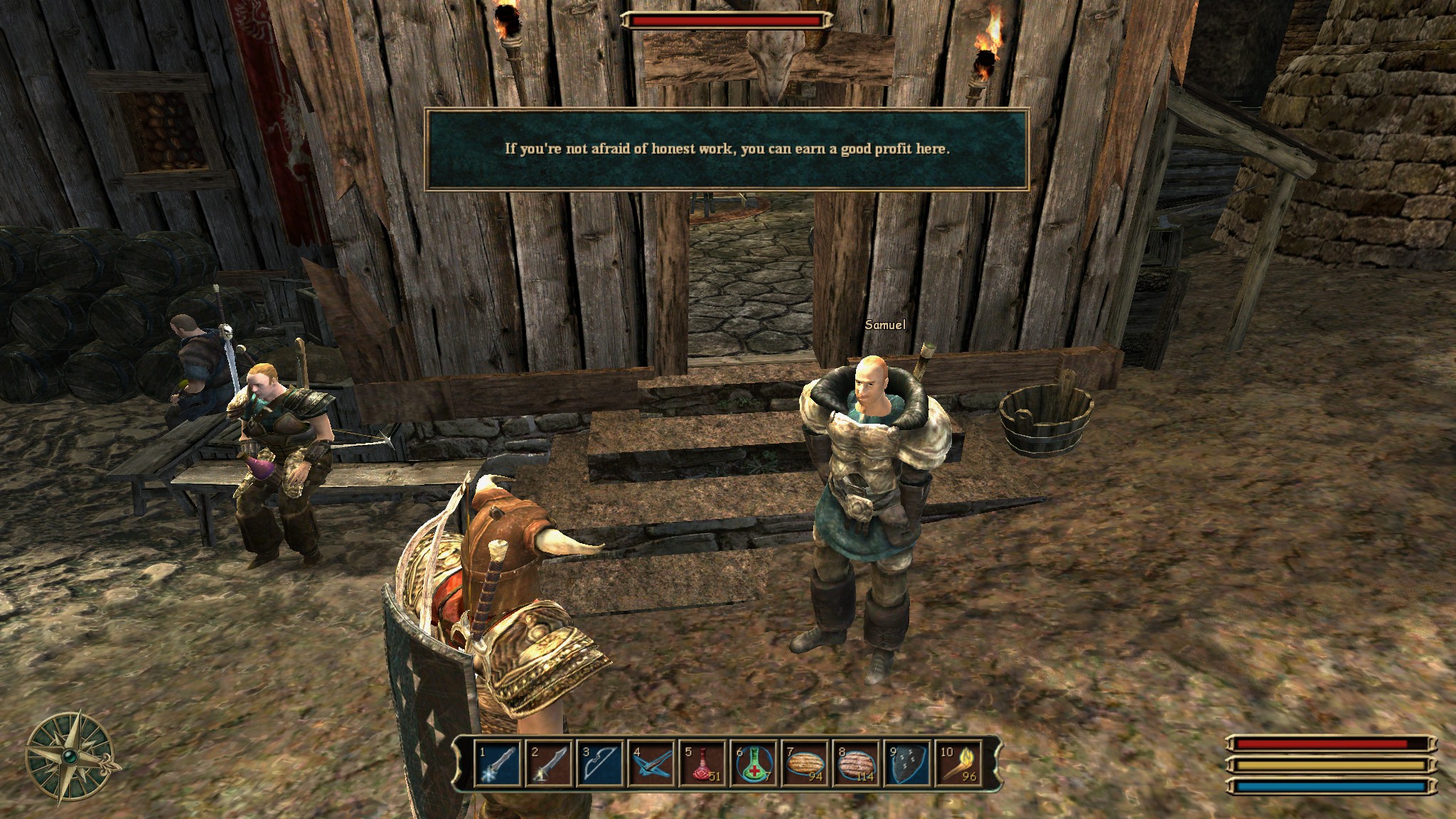
You Load Sixteen Tons and What Do You Get?
This sort of uninterrupted exploration is almost unique to the Gothic series, being rendered impossible in many other open-world RPGs by the constant stress of inventory management.
Your character is restricted by neither weight-based nor slot-based limits on how much he can carry. This offers the player the immense satisfaction of spending hours at a time exploring the wilderness, battling beasts and exploring caves before returning to a city in which to unload hundreds of weapons, pelts, alchemy ingredients and assorted valuables on vendors who usually have enough money to buy them all. This freedom from inventory stress is particularly refreshing in comparison to games like the Elder Scrolls series, where the amount of fun you can have in the wild is often dampened by having to take
immersion-breaking trips to the city almost every time you clear a dungeon, only to find out that you now have to visit every single merchant in the city to unload your loot.
The game’s economy is built with the unlimited inventory in mind, offsetting the great wealth available to the player early on by putting a high price on some of the items you will want to buy. Making your way through the orc army of Nordmar will make you incredibly rich, with the weapons you pickup of their corpses alone being worth several hundreds of thousands of gold coins, a sum that would quickly sink the game’s economy, if it weren’t for the hefty sums you will need to cough up for training, equipment, crafting recipes and, most costly, armour.
Yes, getting better armour in Gothic 3 still feels like a questline in itself. You start out with something just a bit better than Gothic 2’s farmer clothes, you can’t find it as loot anywhere in the game, and the only way you will be offered the privilege to pay an absurd sum of money for a better armour is to have enough reputation with the faction you’re buying it from. One of the reasons I’ve never allied myself with the orcs in any of my playthroughs is that an orc run would prevent me from getting the supremely powerful paladin armour. Plus, you know, they want to enslave the whole human race or whatever.
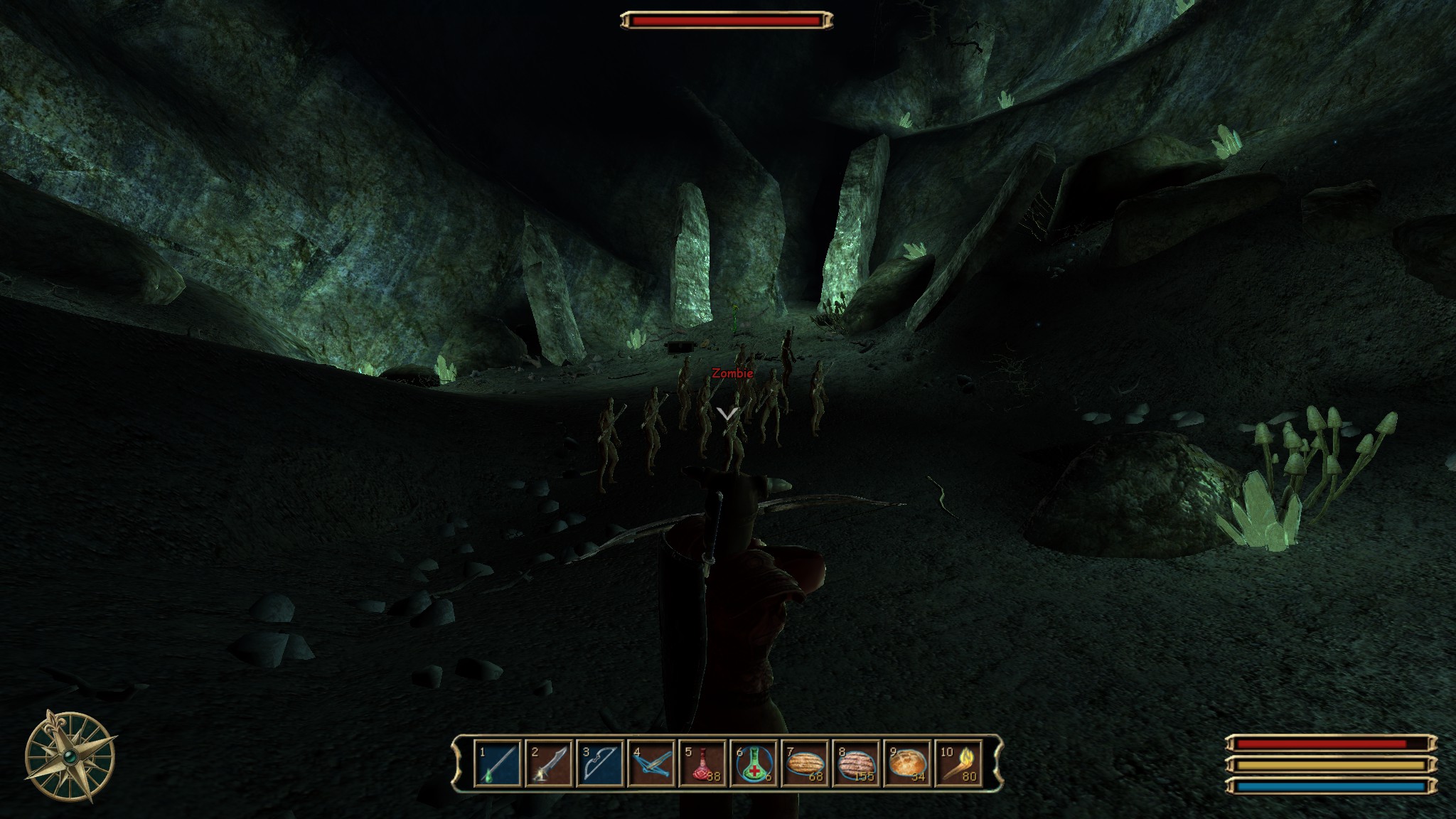
Blinded by the Light
The truth is Gothic 3 is a messy game. It’s not as tightly designed as Gothic 2 and doesn’t have the same level of coziness that the first Gothic had. But in 2006, at the peak of the console scare, when most of the game industry thought RPGs have to be turned into console-friendly action games, Gothic 3 didn’t take that route. It simply made the logical step in the series: Keep the main trappings of the series, but create a larger world with more things to do and bigger stakes. This didn’t work as well as it could have, and the fact that the hundreds of quests, characters and dungeons still occasionally seem “spread too thin” is crazy.
The near unplayable state of the game at launch and fresh memories of its hallowed predecessor make it easy to understand why Gothic 3 was received as a disappointment by fans. Fifteen years later, with the bugs largely squashed and the wool of history drawn snuggly over our eyes, we can see it as it really is: An insanely ambitious game whose developers bit more than they could chew. A flawed gem. Even after years of polishing, the flaws are still there. But most of the time, when everything goes right, they are made invisible by the dazzling, blinding light that shines through. And I’m not talking about that blasted lens-flare effect, either.

